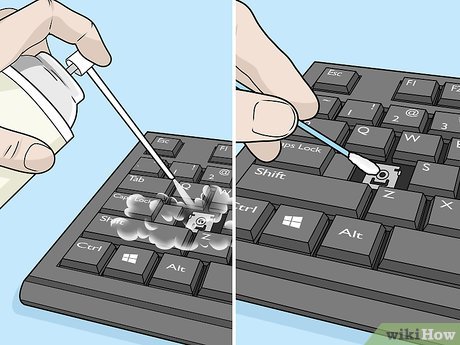Having unresponsive keys on your keyboard can be really annoying. Don’t worry, you don’t need a new one! With some DIY skills and patience, you can replace the problematic keys and make your keyboard work perfectly again. Here’s how:
- Identify the specific keys that are causing the issue. Check if they are physically stuck or not registering when pressed.
- Gather tools like a precision screwdriver set, spare keycaps (if available), and a keycap puller.
- For keys that are stuck, carefully pry them up. Clean any debris or dust underneath. Reattach the keycap.
- For a key that’s not registering, remove the keycap and check the switch beneath for any damage or obstruction. Clean with isopropyl alcohol and cotton swabs.
- To replace a broken switch, desolder it from the circuit board. Solder in a new switch. Reattach the replaced keycap.
Fixing your keyboard is possible with these DIY methods. You can restore your keyboard and unleash your inner tech guru!
Understanding the Issue
Having a problem with your keyboard keys? Not to worry! We’re here to help. Let’s explore the cause of the stuck or unresponsive keys. It could be due to dust, mechanical failure, software issues, or spilled liquids.
To fix the issue, try tapping the affected key multiple times. This could help remove any debris and make it responsive again. If that doesn’t work, blow the key with compressed air.
In more serious cases, you can replace the key yourself. Use a keycap removal tool or a small flathead screwdriver to pry off the key. Then clean the keycap and switch with a cloth and isopropyl alcohol. Finally, press down the new keycap until you hear a click.
Remember to unplug your device before attempting any DIY fixes. With these tips, you can be typing with ease again!
Assessing the Keyboard
When it comes to assessing your keyboard, there are a few main points to consider. Responsiveness of each key, any stuck/unresponsive keys, and the overall condition. Taking these into account will help you decide whether you need a DIY keyboard key replacement.
Look at the table below for details:
| Key Responsiveness | Physical Condition | Stuck/Unresponsive Keys |
|---|---|---|
| ✔ | ✔ | ✔ |
Be aware of any patterns with stuck or unresponsive keys. Consistent failures to register may be a sign of a deeper issue with the circuitry. Paying attention to such signs can help when troubleshooting.
Did you know keyboards have been around since the 19th century? Christopher Latham Sholes patented the first typewriter-style keyboard in 1868. Technology and user needs have since led to various designs with improved ergonomics and functionality.
Tools Needed for Keyboard Key Replacement
For replacing a keyboard key, you’ll need a set of special tools. These are very important for making sure the job is done right. Let’s take a look at the essential tools!
- Screwdriver: You’ll need a small one to take out screws that are holding the key. This gives access to the part below.
- Replacement Key: You need to find one that matches your keyboard model and layout. Find an identical or compatible key for the best fit.
- Tweezers: Handy for handling delicate parts while replacing the key. They give precision and control when putting the new key into place.
- Compressed Air: Dust and debris can build up under keys. This stops them from working. Use compressed air to get rid of these particles.
- Cleaning Solution and Cloth: Sticky residue can stop keys from working smoothly. A cleaning solution and cloth can help remove dirt before installing the replacement key.
Now for some extra details! Get a screwdriver with magnetic features. This makes gripping screws easier and prevents dropping them. When getting a cleaning solution, get one made for electronics. This stops damage to sensitive parts.
Step-by-Step Instructions
Fixing stuck or unresponsive keys on your keyboard is easy. Follow these instructions to get it working again.
- Lift off the key. Gently pry it up with a screwdriver or key puller. Don’t use too much force – it could damage the key or others around it.
- Clean the key and the space beneath it. Get all the dust and debris out using compressed air or a soft brush.
- Check for signs of damage or wear. If you see broken components or loose parts, you may need to replace the switch.
- Reattach the keycap. Line it up with the switch and press it firmly until it clicks. Make sure each side is securely attached.
- Test it out. Press it multiple times to check it’s smooth. If it’s still sticky or unresponsive, repeat the steps or ask for help.
Don’t forget to be careful with your keyboard and avoid eating/drinking near it. Clean it regularly, too. With these steps, you can fix minor issues yourself without needing to replace the whole unit.
Troubleshooting Tips
Troubleshooting tips for fixing stuck or unresponsive keys on your keyboard:
- Clean the keys.
- Check for physical damage.
- Restart your computer.
- Update device drivers.
- Try an external keyboard.
- Consult a professional.
Handle the keys delicately when removing them and disconnect the keyboard from the power source before attempting repairs. Cleaning the keys eliminates obstructions. Check physical damage to identify irreversible issues that require a keyboard replacement. Restart the computer to reset the software. Update the device drivers for compatibility and optimum performance. Use an external keyboard to determine if the built-in keyboard is the problem. Consult a professional for expert analysis and repair of any hardware-related issues.
Follow these tips and suggestions to address stuck or unresponsive keys on your keyboard. Restore its functionality and maximize its lifespan!
Preventive Measures
Keep your keyboard clean and tidy! Compressed air is your friend for removing dust and debris.
Eating or drinking near your keyboard? Don’t do it! A keyboard cover or skin will provide an extra layer of protection against spills and dirt.
Be gentle and don’t type too forcefully. Use a keycap puller tool for occasional cleaning.
Update your device’s OS and drivers to ensure compatibility.
Don’t use excessive force when putting in or taking out USB connectors.
Take care of your keyboard and avoid future inconveniences!
Conclusion
- To start, identify the faulty key. Can it be fixed without replacing?
- If no, get the necessary tools – a keycap puller or flathead screwdriver.
- Then clear out any debris or dust.
- If the problem still exists, replace the key.
- Make sure the replacement is compatible or order one online.
- Align and press down until it snaps into place.
- Test the new key.
Keep these tips in mind: turn off your computer first and handle the keys gently. Follow these steps with patience to get the best results. Happy typing!
Frequently Asked Questions
FAQ 1: How do I fix a stuck or unresponsive keyboard key?
Try gently removing the keycap and cleaning the area underneath with a can of compressed air. If this doesn’t work, you may need to replace the key.
FAQ 2: Can I replace a keyboard key myself?
Yes, you can replace a keyboard key yourself. However, keep in mind that it requires some technical skills and patience. Make sure to follow a tutorial or guide specific to your keyboard model.
FAQ 3: What tools do I need for keyboard key replacement?
You will typically need a keycap puller, a small flathead screwdriver or a pry tool, and a replacement keycap. These tools will help you safely remove and replace the keycap without damaging the keyboard.
FAQ 4: Where can I find replacement keycaps?
You can find replacement keycaps online on websites that specialize in keyboard accessories. Make sure to choose a keycap that matches your keyboard’s layout and switch type.
FAQ 5: My laptop’s keyboard key is stuck. Can I still replace it?
In most cases, laptop keyboards have a different mechanism than desktop keyboards, making key replacement more challenging. It is recommended to consult a professional or contact the laptop manufacturer for assistance.
FAQ 6: Are there any risks involved in DIY keyboard key replacement?
While it is generally safe to replace a keyboard key yourself, there is a risk of damaging the key switch or other components if not done correctly. It is important to follow instructions carefully and proceed with caution.



